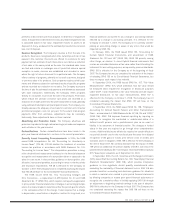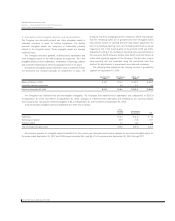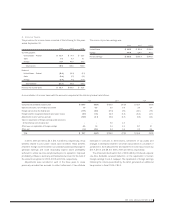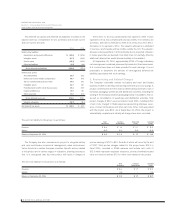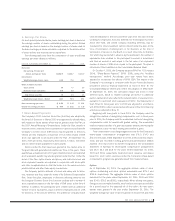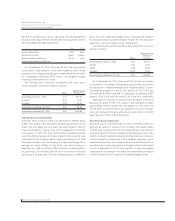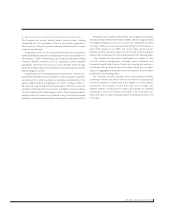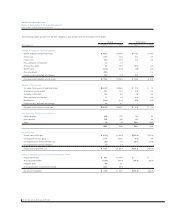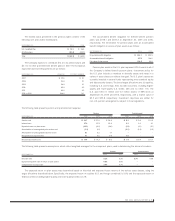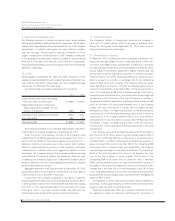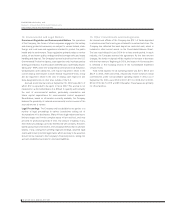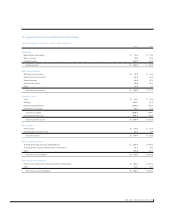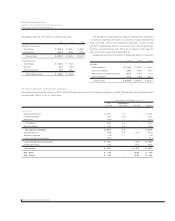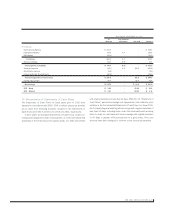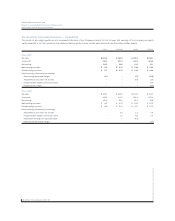Energizer 2006 Annual Report Download - page 39
Download and view the complete annual report
Please find page 39 of the 2006 Energizer annual report below. You can navigate through the pages in the report by either clicking on the pages listed below, or by using the keyword search tool below to find specific information within the annual report.
ENR 2006 ANNUAL REPORT 37
shares of ENR common stock, with no commitments by the Company
to repurchase such shares. Most recently, on July 24, 2006, the Board
of Directors approved the repurchase of up to an additional 10 million
shares and 8.8 million shares remain under such authorization as of
September 30, 2006. During fiscal year 2006, approximately 11.3 mil-
lion shares were purchased for $600.7.
13. Financial Instruments and Risk Management
Foreign Currency Contracts At times, the Company enters into for-
eign exchange forward contracts and, to a lesser extent, purchases
options and enters into zero-cost option collars to mitigate potential
losses in earnings or cash flows on foreign currency transactions. The
Company has not designated any financial instruments as hedges for
accounting purposes. Foreign currency exposures are primarily related
to anticipated intercompany purchase transactions and intercompany
borrowings. Other foreign currency transactions to which the Company
is exposed include external purchase transactions and intercompany
receivables, dividends and service fees.
The contractual amounts of the Company’s forward exchange con-
tracts were $21.3 and $30.8 in 2006 and 2005, respectively. These
contractual amounts represent transaction volume outstanding and do
not represent the amount of the Company’s exposure to credit or market
loss. Foreign currency contracts are generally for one year or less.
Prepaid Share Options A portion of the Company’s deferred compen-
sation liabilities is based on Company stock price and is subject to
market risk. The Company has entered into a net-cash settled
prepaid share option transaction with a financial institution to mitigate
this risk. The change in fair value of the prepaid share options is record-
ed in SG&A in the Consolidated Statements of Earnings. Changes in
value of the prepaid share option approximately offset the after-tax
changes in the deferred compensation liabilities tied to the Company’s
stock price. Market value of the Company’s investment in the prepaid
share options was $50.8 and $20.4 at September 30, 2006 and 2005,
respectively, with approximately 0.7 and 0.4 million prepaid share
options outstanding at September 30, 2006 and 2005, respectively.
The settlement date of the options outstanding at 2006 year-end is
September 28, 2007. The change in fair value of the prepaid share
option for the year ended September 30, 2006 and 2005 resulted in
income of $10.8 and $5.4, respectively.
Concentration of Credit Risk The counterparties to foreign currency
contracts consist of a number of major international financial institu-
tions and are generally institutions with which the Company maintains
lines of credit. The Company does not enter into foreign exchange
contracts through brokers nor does it trade foreign exchange contracts
on any other exchange or over-the-counter markets. Risk of currency
positions and mark-to-market valuation of positions are strictly moni-
tored at all times.
The Company continually monitors positions with, and credit ratings
of, counterparties both internally and by using outside rating agencies.
The Company has implemented policies that limit the amount of agree-
ments it enters into with any one party. While nonperformance by these
counterparties exposes the Company to potential credit losses, such
losses are not anticipated due to the control features mentioned.
The Company sells to a large number of customers primarily in the
retail trade, including those in mass merchandising, drugstore, super-
market and other channels of distribution throughout the world. The
Company performs ongoing evaluations of its customers’ financial con-
dition and creditworthiness, but does not generally require collateral.
The Company’s largest customer had obligations to the Company with
a carrying value of $68.0 at September 30, 2006. While the competi-
tiveness of the retail industry presents an inherent uncertainty, the
Company does not believe a significant risk of loss from a concentra-
tion of credit risk exists with respect to accounts receivable.
Financial Instruments The Company’s financial instruments include
cash and cash equivalents, short-term and long-term debt and foreign
currency contracts. Due to the nature of cash and cash equivalents and
short-term borrowings, including notes payable, carrying amounts on
the balance sheet approximate fair value.
At September 30, 2006 and 2005, the fair market value of fixed rate
long-term debt was $1,454.8 and $965.2, respectively, compared to its
carrying value of $1,485.0 and $1,000.0, respectively. The increase in
fixed rate long-term debt is due to the refinancing of variable rate debt
into fixed rate debt in July 2006. See Note 10 for additional information.
The book value of the Company’s variable rate debt approximates fair
value. The fair value of the long-term debt is estimated using yields
obtained from independent pricing sources for similar types of borrow-
ing arrangements.
The fair value of foreign currency contracts is the amount that the
Company would receive or pay to terminate the contracts, considering
first, quoted market prices of comparable agreements, or in the absence
of quoted market prices, such factors as interest rates, currency
exchange rates and remaining maturities. Based on these considera-
tions, the Company would make a total net payment of $0.1 and $0.3
for outstanding foreign currency contracts at September 30, 2006 and
2005, respectively. However, these payments are unlikely due to the
fact that the Company enters into foreign currency contracts to hedge
identifiable foreign currency exposures, and as such would generally
not terminate such contracts.


